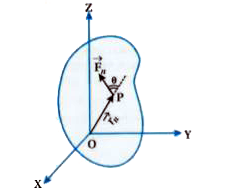Explain the torque acting on a rigid body.
 Solution in Gujrati
Solution in Gujrati
As shown in the figure a rigid body rotates about a fixed axis OZ.
−→F1,−→F2….−→Fn are the forces acting on the particles with position vectors →r1,→r2,→r3…..→rn. Respectively.
The force →Fn is acting on the particle with position vector →rn. The torque on it is given by,
→τn=→rn×→Fn
=∣∣
∣
∣∣ˆiˆjˆkxnynznFnxFnyFnz∣∣
∣
∣∣
∴→τ=ˆi[ynFnz−ZnFny]+ˆj[ZnFnx−xnFnz]+ˆk[xnFny−ynFnx]....(1)
The torque acting on the rigid body can be obtained by taking the vector sum of such torques.
∴→τ=∑nˆi[ynFnz−ZnFny]+ˆj[ZnFnx−xnFnz]+ˆk[xnFny−ynFnx]
The Z component of this torque is responsible for the torsional motion of the rigid body about Z-axis. Similarly X and Y components of torque are responsible for the motion about X and Y axis respectively.
In general if rotational motion is about a fixed axis with ˆn as the unit vector on it, the component of the torque responsible for rotational motion is →τ.ˆn.
In the rotational motion of a rigid body it is not necessary to apply forces on all the particles of the body.
Since the relative positions of the particles of a rigid body are invariant, a torque appliedon any particle can be considered to be the torque on the entire body. So if →F is a force on a particle and →r is the position vector of the particle the torque on the body can be taken as. →τ=→r×→F
Topper's Solved these Questions
- SYSTEMS OF PARTICLES AND ROTATIONAL MOTIONBOOK - KUMAR PRAKASHANCHAPTER - SYSTEMS OF PARTICLES AND ROTATIONAL MOTIONEXERCISE - SECTION-A (TRY YOURSELF (VSQs))
94 Videos
- SYSTEMS OF PARTICLES AND ROTATIONAL MOTIONBOOK - KUMAR PRAKASHANCHAPTER - SYSTEMS OF PARTICLES AND ROTATIONAL MOTIONEXERCISE - SECTION-B NUMERICALS
29 Videos
- SYSTEMS OF PARTICLES AND ROTATIONAL MOTIONBOOK - KUMAR PRAKASHANCHAPTER - SYSTEMS OF PARTICLES AND ROTATIONAL MOTIONEXERCISE - SECTION-F (SECTION-D) QUESTIONS PAPER
1 Videos
- QUESTIONS ASKED IN JEE - 2020 BOOK - KUMAR PRAKASHANCHAPTER - QUESTIONS ASKED IN JEE - 2020 EXERCISE - Question
16 Videos
- THERMAL PROPERTIES OF MATTERBOOK - KUMAR PRAKASHANCHAPTER - THERMAL PROPERTIES OF MATTEREXERCISE - Question Paper (Section - D) (Answer following in brief :) Each carry 4 marks
1 Videos
Similar Questions
What is a rigid body ? Explain the differences between rigid body and solid body.
View SolutionFind the centre of mass of three particles at the vertices of an equilateral triangle. The masses of the particles are 100g, 150g, and 200g respectively. Each side of the equilateral triangle is 0.5m long.
View SolutionA rope of negligible mass is wound round a hollow cylinder of mass 3 kg and radius 40 cm. What is the angular acceleration of the cylinder if the rope is pulled with a force of 30 N? What is the linear acceleration of the rope? Assume that there is no slipping.
View SolutionA non-isotropic solid metal cube has coefficient of linear expansion as 5×10−5/∘C along the x-axis and 5×10−6/∘C along y-axis and z-axis. If the coefficient of volumetric expansion of the solid is n×10−6/∘C then the value of n is....
View SolutionIn an experiment on the specific heat of a metal, a 0.20 kg block of the metal at 150∘C is dropped in a copper calorimeter (of water equivalent 0.025 kg) containing 150 cm3 of water at 27∘C. The final temperature is 40∘C. Compute the specific heat of the metal. If heat losses to the surroundings are not negligible, is your answer greater or smaller than the actual value for specific heat of the metal ?
View SolutionPoint C is the centre of mass of the rigid body shown in figure. Find the total torque acting on the body about point C.
View SolutionA torque of 103N−m acting on a rigid body, turns it throughr 30∘ in 0.2 second. Calculate work done by the body and power of torque.
View SolutionWhen a constant torque is applied on a rigid body, then
View SolutionWhen same torque acts on two rotating rigid bodies to stop them, which have same angular momentum,
View SolutionTorque acting on a rotating body
View SolutionA torque of 103 Nm acting on a rigid body, turns it through 30° in 0.2 second. Calculate the work done by the torque on the body and power of torque.
View SolutionIf a constant torque acts on a body, the body?
View SolutionWhen a constant torque is applied on a rigid body, then
View SolutionWhat is torque? Explain the torque acting on a particle.
View SolutionWhen a constant torque is applied on a rigid body, then
View Solution
